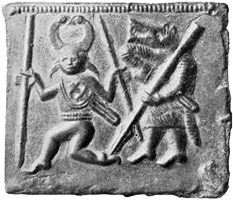
This page created 23 May 2014, and last modified: 12 December 2015 (Maier reference numbers added)

The Equites Brachiati seniores is listed (102/5.5 in Ingo Maier's numbering scheme) as the third of the vexillationes palatinae in the Magister Equitum's cavalry roster; it is assigned (102/5.212) to Magister Peditum's Italian command. Its shield pattern (100#4; but see the following notes), as shown in various manuscripts under the plain label (100.d) Brachiati, is as below:

The shield pattern has a green ground (faded to yellow in M) with a red rim, and a white version of the twin-headed zoomorphic motif that is extremely common among shiled patterns in the Notitia (over a dozen examples), especially amongst auxilia palatina: the version borne by the Equites Brachiati seniores is the only one borne by a unit of cavalry in the Notitia, however. This may not be as significant as it might sound, given how few cavalry units have their patterns recorded; further the Equites Mauri alites (102/5.17) bears a variant of the device, in which the two heads are not conjoined.
In addition to its numerous appearances in the Notitia, the twin-headed zoomorphic motif is known from a range of sources in northern Europe, such as on the ca. 6th century Torslunda bronze die from Sweden shown below:

Note that because the shield pattern is labelled (100.d) plain "Brachiati", and the Notitia includes an Equites Brachiati iuniores (102/5.221) in the Magister Equitum's Gallic command, but not in his cavalry roster (where it was somewhat arbitrarily interpolated by Seeck: OC.VI.46), it is just possible this pattern represent the iuniores unit instead of the seniores (although this must be considered unlikely given the position of the pattern on the page, which ill-suits the lower-ranked iuniores).
The name Brachiati ("Bracchiati" is often found outside the Notitia) is usually taken to refer to upper arm bracelets (bracchia), or trousers (brachae), and is shared with five other units in the Notitia: in the west, the Brachiati seniores (98/9.35), one of the auxilia palatina in the Magister Peditum's Italian command; the Equites Brachiati iuniores (12.3), one of the vexillationes palatinae under the Magister Militum Praesentalis II in the eastern half of the empire; in the west, another unit called the Equites Brachiati iuniores (102/5.221), and as mentioned above, assigned to the Magister Equitum's Gallic command but missing from his cavalry list; in the east, the Brachiati iuniores (9.25), a unit of auxilia palatina under the command of the Magister Militum Praesentalis I; and in the west, another unit called the Brachiati iuniores (102/5.117), in the Magister Equitum's Gallic command, and which is probably the same as the of auxilia palatina called the plain Brachiati (98/9.71) in the Magister Peditum's infantry roster. The shield patterns for both of the Equites Brachiati iuniores (assuming they are in fact different units) as well as the western infantry Brachiati (iuniores) are not recorded (again, assuming it is in fact a different unit from the eastern one); those of the other three units are given below, using the pictures taken from the Parisian manuscript, P:

Inscriptional evidence for the Equites Brachiati seniores comes from the cemetery at Colonia Iulia Concordia (modern Portogruaro in Veneto, Italy), which produced an inscription (ILS 514; photo here) mentioning the unit in the form of the N BRAC SEN EQVIT, which expands to the "n(umero) Brac(chiatorum) sen(iorum) eq(uitum)". Another (CIL 5,8760) gives the NVMERO EOVIIVM BRACCHIAIORVM, which is interpreted to mean the "numero e[q]ui[t]um Bracchia[t]orum"; this however even more likely refers to the Equites Brachiates seniores.
1. Maier, Ingo; "Appendix 4: Numeration of the new edition of the compilation 'notitia dignitatum' (Cnd)"; last accessed 26 October 2015. See also for here for numbering examples. Return
2. Stjerna, Knut; "Hjälmar och svärd i Beovulf"; I: Studier till&aumgnade Oscar Montelius 19 9/9 03 / af l&aumrjungar, Stockholm (1903). Return
3. Seeck, Otto (Ed.); "Notitia Dignitatum accedunt Notitia urbis Constantinopolitanae et Latercula prouinciarum", Weidmann, Berlin, 1876; available here (last accessed 26 October 2015). Return
4. Hoffmann, Dietrich; "Die Spätrömischen Soldatengrabschriften von Concordia"; Schweizerische Zeitschrift für klassische Altertumswissenschaft, Vol. 20.1 (1963), pp 22-57; available here (last accessed 8 December 2015). Return

Return to the Notitia alphabetical unit list page.
Return to my Notitia index page.